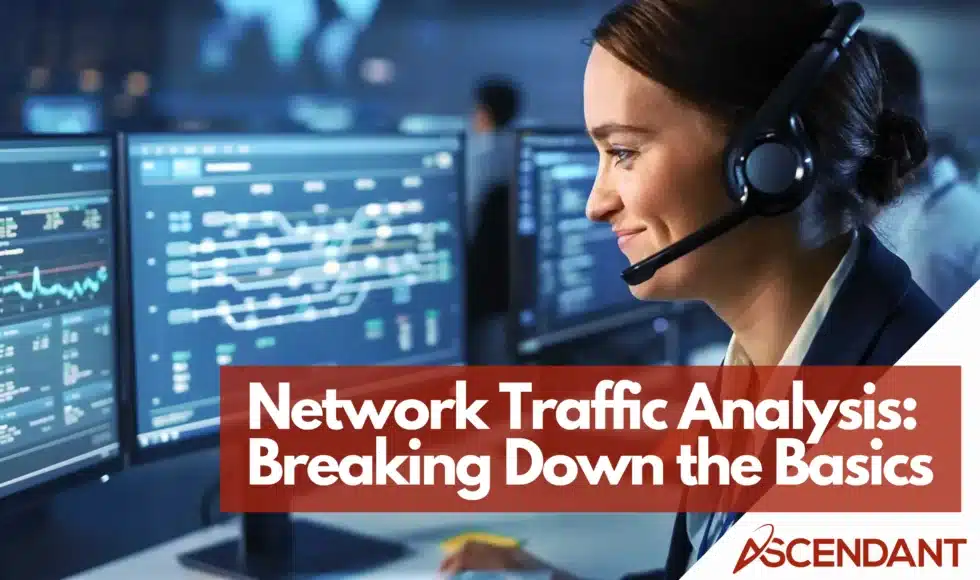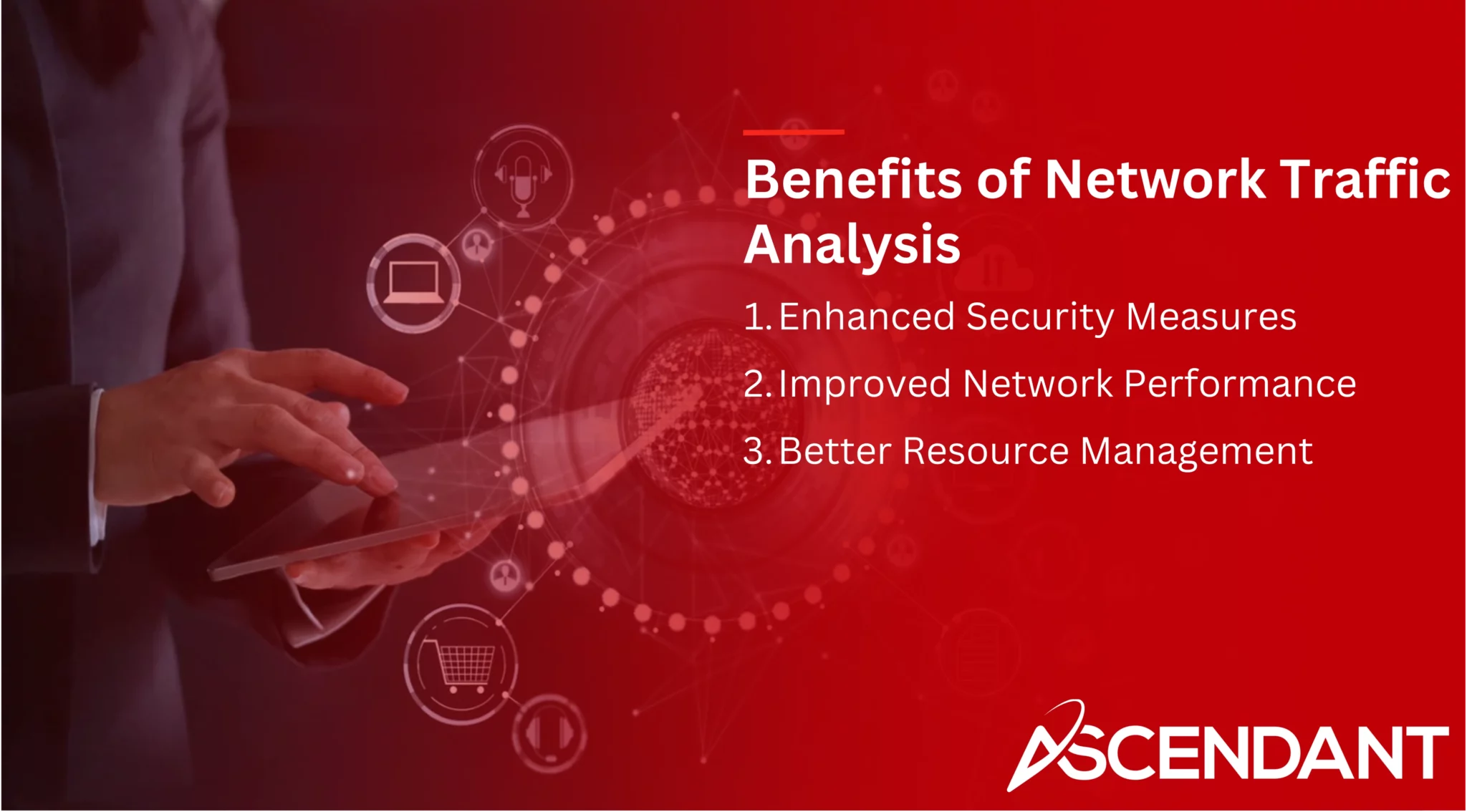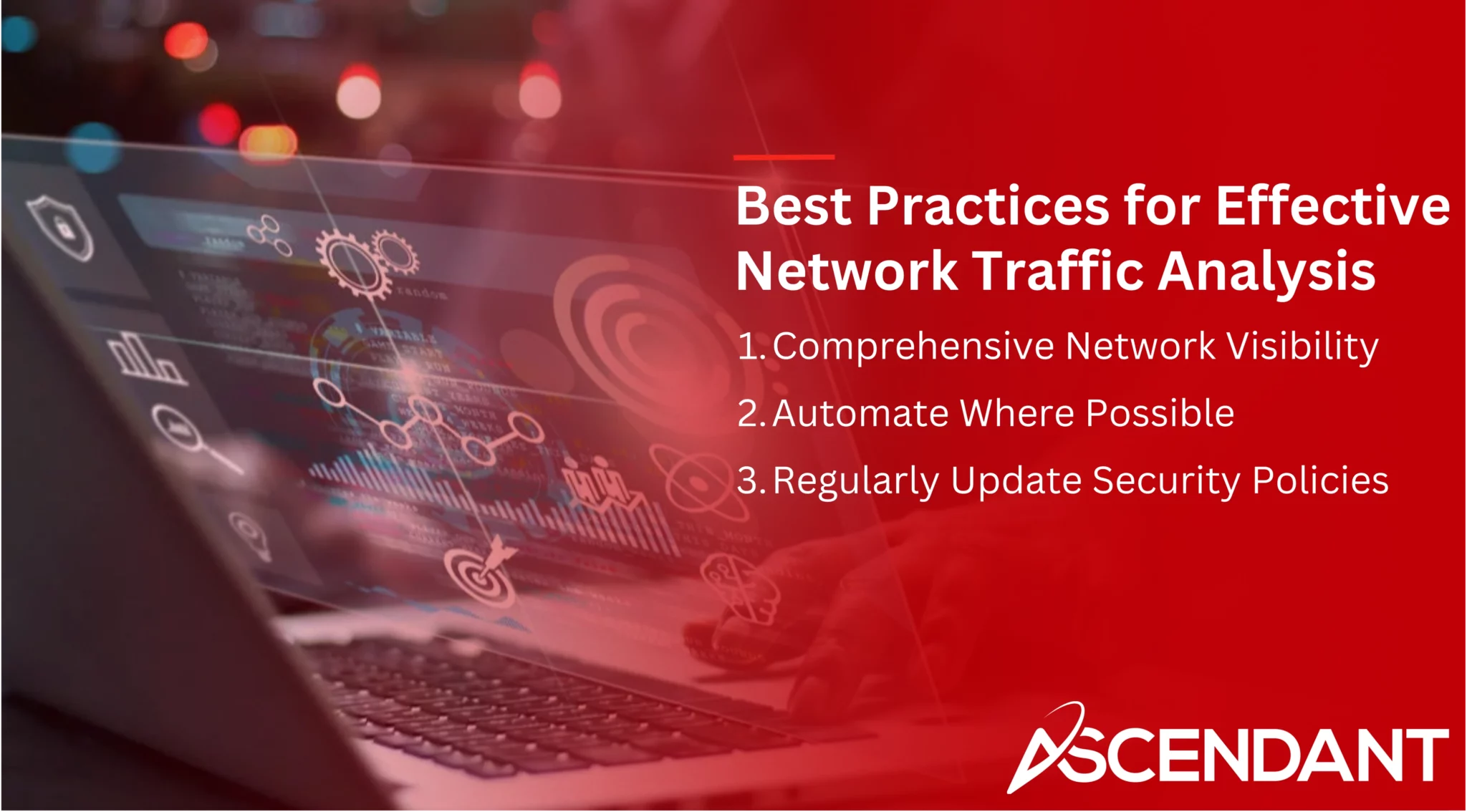Network traffic analysis is the process of examining data flows within a network to enhance performance and security. By identifying potential issues before they escalate, it ensures optimal network health and robust security. In this article, we will explore the essential tools, techniques, and best practices needed for effective network traffic analysis.
Key Takeaways
- Network Traffic Analysis (NTA) enhances network performance and security by providing comprehensive visibility of network behavior, allowing for early detection of anomalies and potential threats.
- Implementing effective NTA requires identifying relevant data sources, choosing suitable data collection methods, and setting up continuous monitoring systems to ensure real-time analysis.
- The future of NTA is being shaped by advancements in machine learning and behavioral analytics, which improve the detection of anomalies and enhance operational efficiency.
Understanding Network Traffic Analysis
Network Traffic Analysis (NTA) entails the collection and examination of network data to gain insights that can improve overall network performance. The objectives driving this analysis are threefold: to bolster network management, elevate security measures, and solve operational challenges. Consider NTA a proactive health check for your network—it doesn’t just track current conditions but also anticipates future complications.
Performing effective Network Traffic. Analysis requires careful scrutiny of several components such as traffic flow data, packet information, along with different kinds of networking exchanges like TCP/IP packets and API communications. This deep dive into how data traverses the network assists administrators in mapping out normal traffic patterns, identifying unusual activity swiftly, thereby ensuring peak operation efficiency. Such detailed insight is vital for preserving expected behaviors across networks while quickly rectifying any deviations from these norms.
One major advantage offered by Network Traffic Analysis is its ability to provide expansive visibility through detailed telemetry gathered across all aspects of the networking infrastructure. By understanding standard operations within their environments—what’s considered “business as usual”—network professionals can more readily detect outliers hinting at potential risks or functional hiccups—a critical aspect given that ongoing vigilance supports robust availability and finely tuned system response.
In essence, mastering Network Traffic Analysis transcends simple oversight over moving data bits. It encompasses acquiring an intricate understanding of how your entire digital ecosystem operates at both micro- and macro-levels to safeguard against threats while steering toward utmost efficacy in handling business transactions digitally—the hallmark being improved transparency over flows which anchors fortified defensive lines alongside seamlessly operational landscapes.
Benefits of Network Traffic Analysis
Analyzing network traffic yields numerous advantages, such as fortified security protocols, heightened network performance, and more effective management of resources. By employing tools designed for analyzing network traffic, entities can gain a profound comprehension of their traffic patterns, which in turn aids them to fine-tune their networking environment adeptly. These enhancements are pivotal for sustaining an infrastructure that is both resilient and operates at peak efficiency.
The essence of network traffic analysis transcends mere surveillance of data flow. It involves the conversion of raw data harvested from the network into valuable insights. With these insights at hand, organizations can unearth unauthorized usage within the system while pinpointing areas causing reduced performance and judiciously administer resources to where they are most needed.
In subsequent sections below we will delve deeper into each benefit provided by this practice. It’s clear how critical robust analysis mechanisms have become – they have essentially transformed into linchpins that could revolutionize your organizational processes through enhanced understanding and management of your digital operations landscape.
Enhanced Security Measures
The enhancement of network security is one of the primary advantages offered by the analysis of network traffic. Tools dedicated to this purpose are adept at identifying irregular activities and deviations from normal traffic patterns within a network infrastructure. By alerting security teams to these anomalies, they facilitate quicker identification of potential threats that can come from outside or inside the organization. Adopting such preventative measures is vital for upholding robust defense mechanisms in the face of modern cyber dangers.
With Network Traffic Analysis (NTA), there’s an umbrella view over diverse settings, be it on-site systems, cloud-based services, or hybrid models. This expansive scope for monitoring allows security squads to pinpoint menaces that may have eluded traditional boundary defenses or those emerging internally. In instances where aberrations in traffic are observed, automated protocols can enact immediate countermeasures – a key tactic ensuring timely intervention during any breach or unusual event.
Strengthening its role in safeguarding networks, ongoing surveillance through NTA tools plays an instrumental role in detecting ransomware offensives and other nefarious behaviors promptly. Persistent scrutiny over user conduct and attempts to connect delivers essential insights into potentially harmful actions, allowing NTA instruments not only to highlight but also act swiftly on such irregularities. The constant updates afforded by this technology ensure that vigilance against intrusion remains strong amidst ever-shifting cybersecurity challenges.
Improved Network Performance
The objective of network traffic analysis is to bolster the uninterrupted and consistent availability of networks, which plays a vital role in maintaining operational continuity. By scrutinizing traffic patterns within the network, organizations can reduce instances that may negatively impact user experiences and enhance overall network performance. Consequently, this ensures that networks are constantly functioning at their highest efficiency levels for an uninterrupted user experience.
Network traffic analysis tools also serve as invaluable instruments in observing data packets as they traverse the network. These insights address aspects like performance metrics, security postures, and bandwidth utilization. With such software-based analyses in place, it’s possible to identify specific applications or services that might be utilizing disproportionate amounts of bandwidth and adjust accordingly to optimize resource allocation.
Technologies akin to NetFlow offer a flow-centric approach to monitoring these statistics and trends pertaining to network usage over time. The result of this persistent surveillance is enabling businesses not only to sustain but also continually refine their operations for prime effectiveness – guaranteeing both excellent management of resources across their networks as well as sustaining premium-grade service delivery marked by optimal traffic flows.
Better Resource Management
Network traffic analysis helps in the efficient allocation of network resources by identifying underutilization and enabling organizations to make informed decisions regarding resource deployment. Analyzing network usage patterns allows organizations to reduce costs associated with unused resources and optimize existing infrastructure.
The insights gained from network traffic analysis lead to streamlined operations, improving overall productivity and responsiveness within the organization.
Implementing Network Traffic Analysis
Setting up network traffic analysis necessitates a few essential actions, such as pinpointing the origins of data, selecting methodologies for gathering data, and instituting systems that facilitate constant monitoring. These measures are indispensable to certify that processes related to network traffic analysis yield effective outcomes and deliver the anticipated intelligence.
Subsequent segments will navigate you through these specific steps one by one to assist in constructing a solid framework for analyzing your network traffic.
Identify Data Sources
It is essential to pinpoint the appropriate data sources when undertaking an analysis of network traffic. The range of sources from which data can be gleaned encompasses on-premises and cloud-based routers, servers, switches, firewalls, and applications. By monitoring this network traffic closely, one not only discerns the involvement of IoT devices, but also monitors their connectivity—thereby bolstering security.
For a successful analysis of traffic flow across networks, security analysts are tasked with determining which services and assets should take precedence in the scrutiny process.
Choose Data Collection Methods
There are two primary strategies for gathering network traffic data: agent-based and agentless techniques. Agent-based methods require the installation of small software on devices to monitor their performance, whereas agentless approaches frequently rely on protocols such as Simple Network Management Protocol (SNMP) to conduct surveillance.
When considering tools for assessing volume metrics in network management, options like SNMP and streaming telemetry may influence the decision between using an agent-based or an agentless system.
Continuous Monitoring Setup
The practice of consistent observation of network traffic is key to uncovering security violations, pinpointing failures within the network, and acquiring insights over extended periods. During the implementation phase of traffic analysis systems, select apparatus that aligns with your organization’s current networking status. This means opting for virtual solutions in relation to virtual infrastructure and physical hardware for on-site networks. Storage selections available for network traffic analysis solutions encompass specialized hardware configurations, database systems hosted virtually or monitoring software deployed either on material devices or digital environments.
Executing a perpetual monitoring system transcends mere selection of suitable equipment—it requires flawless incorporation into existing network frameworks. This seamless integration empowers immediate examination and swift identification of any irregularities in data flow patterns. By doing so, it preserves optimal function and fortified protection across the entirety of the networking sphere at all times.
Essential Tools for Network Traffic Analysis
The efficacy of analyzing network traffic is greatly dependent on the selection of appropriate tools. These instruments for examining network traffic come in various forms, namely flow-based tools, packet-based tools, and Software as a Service (SaaS) solutions. They each possess distinctive characteristics and advantages that render them apt for various types of networks and specific needs.
Subsequent segments will delve into these distinct categories comprehensively, providing guidance to assist you in selecting the most fitting network traffic analysis tool tailored to your organization’s requirements.
Flow-Based Tools
By scrutinizing flow data, organizations utilize flow-based utilities to gauge network traffic, which is pivotal for discerning the health and protection of their networks. Instruments such as NetFlow, sFlow, and IPFIX stand out in this domain with distinctive capabilities tailored for supervising and dissecting network performance. These applications are instrumental in refining network efficiency, pinpointing security hazards, and stewarding resources judiciously.
The analysis of flow data equips entities with profound insight regarding usage statistics and traffic configurations. Such knowledge is vital to sustain prime network functioning while ensuring resource distribution is executed effectively. The adoption of these flow-based solutions grants enterprises a heightened comprehension of their network flows facilitating astute choices that bolster operational productivity.
Packet-Based Tools
Deep packet inspection tools offer complete network visibility by providing an intricate examination of network traffic. Such analysis is vital for understanding the nuances of data movement and identifying irregularities within the network, thus allowing organizations to pinpoint and resolve particular problems efficiently.
SaaS Solutions
Network traffic analysis solutions based on Software as a Service (SaaS) offer an advanced method for monitoring and handling network traffic, which improves operational effectiveness. Such scalable designs enable organizations to accommodate increasing demands of their networks while obtaining insights across different devices.
These SaaS-based tools grant immediate clarity regarding the performance of networks, empowering quick decisions and enabling proactive oversight of the system’s functioning.
Best Practices for Effective Network Traffic Analysis
To optimize outcomes from analyzing network traffic, it is critical to adhere to established best practices. Such practices include ensuring extensive visibility of the network, implementing automation in processes where feasible, and consistently updating security protocols. By following these guidelines rigorously, efforts in traffic analysis are rendered more effective and yield insights that can be acted upon.
Subsequent sections will explore each of these best practices with greater specificity.
Comprehensive Network Visibility
Gaining complete visibility is essential for network administrators in pinpointing which applications, users, protocols, or groups of IP addresses are utilizing the most bandwidth. It’s vital to thoroughly analyze each data packet for an intricate comprehension of both user activity and application behavior across the network. This detailed examination of network traffic enables precise identification and resolution of distinct problems.
Monitoring systems must take into account adherence to regulatory compliance and restrictions specific to local networks as part of successful data gathering efforts. A phased approach should be adopted when deploying traffic analysis on the network. This strategy ensures that every element operates properly before progressing towards a comprehensive rollout.
Automate Where Possible
Utilizing automation for detection processes not only minimizes the required resources, but also amplifies the capabilities of identifying threats. Detection mechanisms that adhere to specific rules are designed to thwart particular attack methodologies and strategies, involving correlation among various parameters like assets involved, time frames, and communication protocols used. The integration of automation within network traffic analysis is crucial in bolstering the ability to detect anomalies while reducing human intervention.
Embracing automated detection procedures offers enhanced operational efficiency and bolsters confidence in securing networks. By implementing automation across feasible areas, efforts dedicated to analyzing network traffic become more proficient and productive.
Regularly Update Security Policies
Cybersecurity policies must be dynamic to effectively counter evolving threats. Using network traffic analysis increases the ability to detect unusual behaviors indicative of ransomware and other threats. Organizations that fail to maintain dynamic cybersecurity policies risk increased vulnerability to attacks.
Regularly updating security policies ensures that the security team’s defenses remain robust and effective against new and emerging threats.
Challenges and Solutions in Network Traffic Analysis
Analyzing network traffic offers numerous advantages, yet it is not without its difficulties. Issues such as the quality of data, constrained budgets, inadequate training for personnel, and varying requirements for data input can all pose significant challenges. The capabilities of analytical tools might be undermined by their inherent restrictions as well as a lack of user knowledge about these limitations.
Subsequent subsections will delve deeper into these impediments to effective network traffic analysis and propose strategies to surmount them.
Managing Large Volumes of Data
Managing the sheer quantity of network traffic data often necessitates a strategic approach to critical data collection, aiming to reduce unnecessary consumption of resources. By tapping into high-performance computing capabilities, organizations can significantly improve their handling and analysis of sizable datasets in the context of network traffic control. The effectiveness of network traffic analysis hinges on the capacity to acquire and process extensive data sets swiftly in real-time settings to sustain optimal performance levels. Concentrating on crucial sources of information while employing cutting-edge technologies empowers organizations to handle copious amounts of network traffic data with proficiency.
To navigate through massive volumes of data efficiently, it’s vital that one employs robust filtering methods. These tactics are instrumental for sifting through relevant information amid a vast sea generated by voluminous network activity. Emphasizing essential pieces and deploying potent computational tools underpin effective operations within networks even when confronted with substantial quantities of data at play.
Ensuring Data Privacy and Compliance
Tools for analyzing network traffic are instrumental in aiding organizations comply with regulatory requirements by offering the necessary oversight and audit functions to keep track of network behavior. These tools yield comprehensive summaries and records pertaining to network traffic and occurrences related to security, which aid in affirming conformity with industrial norms. Through leveraging the use of these analysis instruments, companies can take preventive measures against security threats while upholding the integrity of their data.
The global emergence of privacy regulations has introduced intricate compliance hurdles for businesses. Traffic analysis within networks serves as a tool for pinpointing potential breaches in compliance such as illegitimate entry into confidential information or incorrect movements involving data.
It is critical that enterprises perform analyses on client-side network activity so as to recognize any issues associated with CMP functionality. Given that under many privacy legislations firms may be regarded as data controllers, there is an inherent obligation upon them to ensure their Content Management Platforms (CMPs) operate accurately.
Future Trends in Network Traffic Analysis
Advanced network traffic analysis tools are increasingly adopting machine learning and behavioral analytics to enhance their capabilities. By applying these sophisticated analytic methods, there is a notable improvement in the handling of extensive network traffic data. These evolving self-learning technologies are being integrated into the tools used for analyzing network traffic, enabling them to proactively detect and address threats before they impact network performance.
To boost anomaly detection and automate insights within SaaS-based solutions for analyzing network traffic, machine learning technology is frequently incorporated. The benefit of this integration is that it facilitates immediate identification of irregularities as well as automatic actions aimed at preserving optimal security and performance levels on networks.
Looking forward, with continuous advancements in these areas, we can anticipate an even brighter future for the field of traffic analysis. We expect more complex analytical techniques and advanced tools designed to Elevate our ability to manage and interpret network data effectively.
Summary
To summarize, becoming proficient in network traffic analysis requires a solid grasp of the basic principles, utilizing appropriate tools, applying recommended practices, and anticipating upcoming developments. Such expertise allows entities to bolster their network security posture while optimizing performance and efficiently allocating resources. With the field of network traffic analysis perpetually advancing, keeping abreast of novel technologies and strategies is crucial for sustaining a resilient and effective network framework.
 Frequently Asked Questions
Frequently Asked Questions
What is Network Traffic Analysis (NTA)?
Analyzing network traffic, known as Network Traffic Analysis (NTA), plays a crucial role in enhancing the efficiency, security, and management of network performance by scrutinizing flow and packet data collected from the network. This examination offers critical understanding into how communications occur within networks.
How does network traffic analysis enhance security?
Network traffic analysis enhances security by detecting abnormal traffic patterns and enabling prompt responses to potential threats. This comprehensive visibility allows security teams to identify and address both external and internal risks effectively.
What are the benefits of using flow-based tools for network traffic analysis?
Using flow-based tools for network traffic analysis offers significant benefits, such as enhanced understanding of network performance and security through detailed insights into traffic patterns.
This optimization leads to improved resource management and overall network efficiency.
Why is it important to regularly update security policies?
Regularly updating security policies is essential to counter evolving threats and protect against vulnerabilities. This proactive approach helps organizations detect unusual behaviors, thereby enhancing overall network security.
What are the future trends in network traffic analysis?
The future of network traffic analysis will be significantly shaped by the integration of machine learning and behavioral analytics, enabling improved anomaly detection and automated responses.
As SaaS solutions increasingly adopt these technologies, they will offer real-time insights and streamline network management.



